In January, before the weather was good enough to do much in the garden, we started out the season by attending our first fruit tree scion exchange.
A few weeks later we then attended a grafting workshop hosted by the California Rare Fruit Growers (CRFG). Then in mid-March we ventured into grafting 8 apple trees (technically 6 apples, and 2 crab apples).
Each scion was cleft grafted to M-111 apple rootstock, and potted into 1 gallon containers. Since then the grafted trees have been kept in partial sun, receiving sunlight in the early part of the day, but protected from the scorching sun in the afternoon.
It’s now been six weeks since the scions were grafted to their new rootstocks. We’d hoped at least a few would take, but expected a few failures as we hadn’t grafted before. Besides, the orchard is almost full, and if they all survived, we might have trouble figuring out where to put them all!
Well…they survived! All eight of them!
The Wickson crab apple burst into spring, and was not only the first to push growth, but it even bloomed.
Any of the grafts that have bloomed this spring will not be allowed to fruit. Setting fruit at this stage will take important energy away from root and scion growth, and risks breaking the scion under the weight of the fruit.
The next most robust of the group is Allen’s Everlasting, which is putting on an impressive display for being not much taller than a pencil!
King David didn’t bloom, which is fine, but instead is surging ahead with new foliar growth.
Not too far behind is Hauer Pippin. Of all of the scions we acquired, we’re most excited to see this one thrive as it’s a local variety of apple.
The slowest of the grafts to push growth is Arkansas Black. This scion was less than ideal at the time of grafting, already looking a little dry when we first acquired it, so that it’s growing at all has surprised us.

If King David is the hare...Arkansas Black is definitely the tortoise in this race, but slow and steady will hopefully get there in the end
Of course, the trees are still very young, and vulnerable to thermal stress, and drying out. For now we will transplant these grafted trees into larger containers to prevent the roots from becoming constricted.

Protecting the tender grafts from hot afternoon sun is important until the grafts are well established
We also need to keep any rootstock growth in check. Early on some foliar growth from the rootstock is thought to help produce energy for the scion, but rootstocks can quickly out-compete scion growth, so occasionally trimming rootstock leaf growth will be necessary until the apples are planted out.
In winter, when the trees are dormant and the stress of summer heat has passed, we’ll make room for these trees to be transplanted in the orchard.
I could be wrong, but I think we’re going to see a lot of apples at Curbstone Valley in the future!

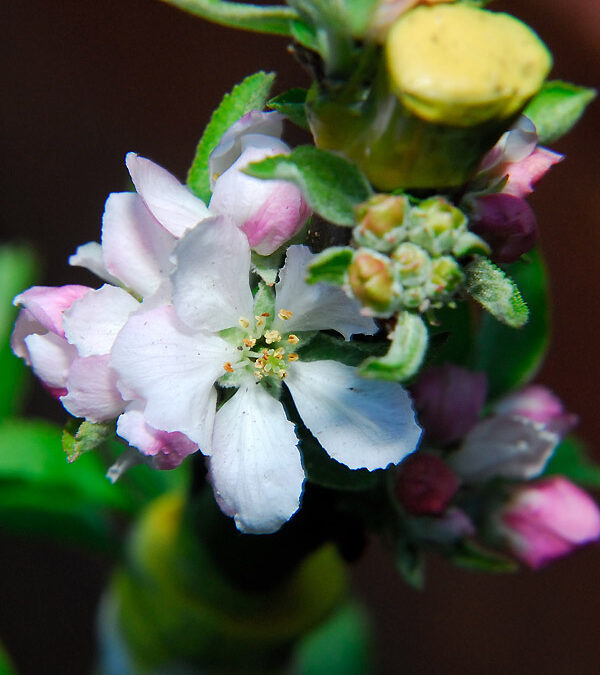
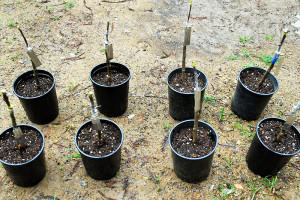

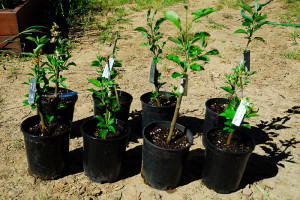
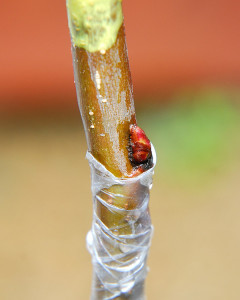


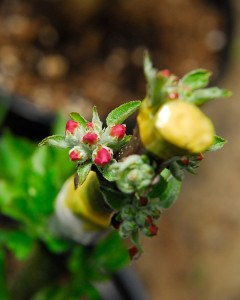
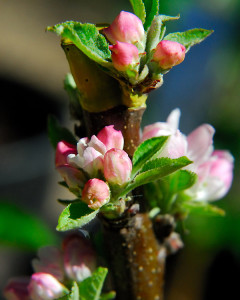

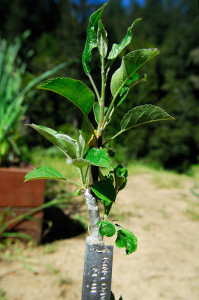
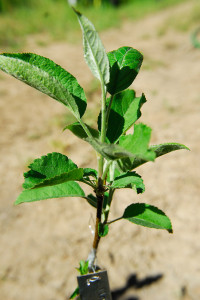
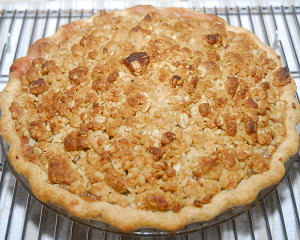







You must have done a great job…they all survived. Congratulations!
Thanks! We were told that apples, of all the fruits, are the easiest to graft. We’d certainly do it again 🙂
Very nice results! I am jealous…but I do not have any more room to plant more fruit trees in my yard. My family can dream with you about apple pies…:)
The beauty of grafting is that if you already have an apple tree for example, you can use a whip-and-tongue method (not the cleft method we used) to graft additional varieties of apples to our existing tree. It’s a fabulous way to increase variety, and prolong harvest, in a smaller space. I’ve seen this done a lot with persimmons, and once saw someone with more than 30 varieties of persimmon on one tree!
I did not realize that they bloom when so small. Plus they seem to grow pretty fast too. Nice crop coming. Pies too.
We didn’t expect blooms this season at all. It’s fun getting a sneak peak at the blossoms though. I can just imagine how stunning Wickson will look as a mature tree. I’m sure our bees will love it!
Awesome post, dear Clare. You are a bundle of informative energy … good luck with the grafts and enjoy dreams of apple pie (now where is my cyber fork … )
We’ll be sure to pass around the cyber forks with our first harvest. Maybe our cyber cider mugs too! 😉
Great success and satisfaction to have all eight sprout! It’s an interesting process that you’ve explained well.
It is an interesting process. I love that plants are so pliable. We’re looking forward to trying some of the other grafting methods in the future. I think we might be maxed out on trees, but we can still graft new varieties to existing ones 🙂
That is so cool! I wish I could have an apple tree, but for now I will have to settle with seeing them online
I knew all would live, if you do grafting right and water them protected from the heat of the sun it is hard to fail. Looks like you’ll be finding new places in the orchard for these little beauties!
You had more faith in us than we did! 😉 Now that we know how easy apples are to graft, I rather wish we’d tried it sooner!
I have yet to try grafting but it looks like a great way to grow an orchard without having to buy more tree’s. We have about thirty peach trees, maybe I’ll experiment with some grafting and see if we can make that 40:) Great blog and picks I enjoy reading up on the latest going ons at your farm.
It’s definitely cost effective. I’m not sure how expensive peach rootstocks are, but our M-111 apple rootstock was about $3 a piece. Of course, with existing peach trees, you could also try grafting new cultivars to existing trees too, at least to test them first, before committing space in the orchard for a whole tree. If the new one doesn’t work out, you can just prune it back off the tree!
Congrats!!! I’m sure the learning and preparation you put in ahead of time are the reason for such awesome success. Looking forward to seeing them planted!
We did have some great instruction at the CRFG classes. I can’t wait for them to go in the ground, but at the moment our weeds and wildflowers in the orchard are taller than these trees, and we’d probably lose them! 😛
This was such an interesting post. Thank you for sharing your experience. I have never tried grafting before but this will enspire me to try.
Huge congrats on such happy little apple trees! What a success, I am so excited for you!
Isn’t it an interesting problem when multiple iffy plants survive? I was sure one of my black sages wouldn’t made it, but now they both want to be 8 feet wide…
Good luck with those little trees, and figuring out where to put them. What a great problem to have.
You make it sound like we all might have luck with grafting. I haven’t tried it in years and I’m sure I really had no idea what I was doing. Instead of eight out of eight successes my results were more like zero out a pretty big number. It sounds like picking the proper season can make all the difference…